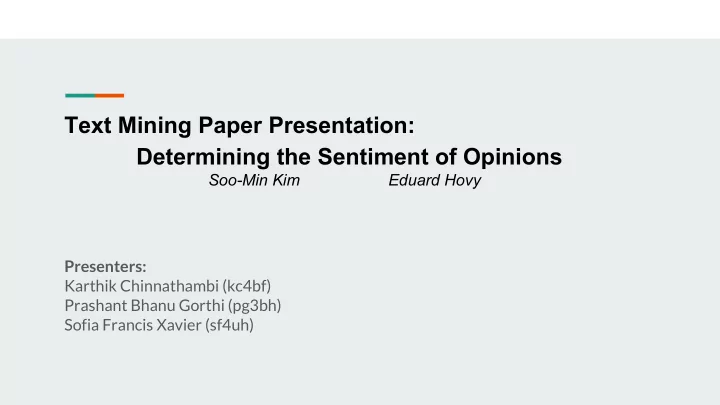

Text Mining Paper Presentation: Determining the Sentiment of Opinions Soo-Min Kim Eduard Hovy Presenters: Karthik Chinnathambi (kc4bf) Prashant Bhanu Gorthi (pg3bh) Sofia Francis Xavier (sf4uh)
Background Opinion: [Topic, Holder, Claim, Sentiment] ● Topic : Theme of the texts ● Holder : Person and Organization ● Claim : Comment about the topic ● Sentiment : Positive, Negative and Neutral ●
Problem Addressed Given a Topic and a set of texts about the topic, find the Sentiments expressed about the Topic in each text, and identify the people who hold each sentiment.
Algorithm Given a topic and a set of texts, the system operates in four steps. Select sentences containing both the topic phrase and holder candidates ● Delimit the regions of opinion based on holder ● Calculate the polarity of all sentiment-bearing words individually using the sentence sentiment ● classifier Combine all the polarities to produce the holder’s sentiment for the whole sentence ●
Architecture
Sentiment Classifiers Word Sentiment Classifier ● Sentence Sentiment Classifier ●
Construction of sentiment seed list Sentiment-bearing words: adjective, verb and noun ● seed lists : randomly selected verbs (23 positive and 21 negative) and adjectives (15 ● positive and 19 negative), adding nouns later. For each seed word, extract from WordNet its expansions and add them back into the ● appropriate seed lists. finally 5880 positive adjectives, 6233 negative adjectives, 2840 positive verbs, and 3239 ● negative verbs. Challenge: Some words are both positive and negative!
Resolving sentiment ambiguous words Given a new word use WordNet to obtain a synonym set of the unseen word argmaxP ( c | w ) ≅ argmaxP ( c | syn1, syn2,....synn) c is a sentiment category (positive or negative) ● W is the unseen word ● synn are the WordNet synonyms of w. ●
Word Sentiment Classifier Model 1 : fk: kth feature of sentiment class c and a member of the synonym set of w count(fk,synset(w)): total number of occurrences of fk in the synonym set of w. Model 2 : P(w|c) : Probability of word w given a sentiment class c.
Sample Output of the Word Sentiment Classifier
Sentence Sentiment Classifier Holder Identification ● Sentiment Region ● Sentence Sentiment Classification Models ●
Holder Identification BBN’s named entity tagger IdentiFinder to identify potential holders of an opinion ● Consider PERSON and ORGANIZATION as the possible opinion holders ● For sentences with more than one Holder, chose the one closest to the Topic ●
Sentiment Region
Sentence Sentiment Classification Models
Experiments Two sets of experiments to examine the performance of: Different word level classifier models ● Different sentence level classifier models ● Classification task defined as assigning each word / sentence as: Positive ● Negative ● Neutral or N/A ●
Experiments: Word Classification Training Data Basic English word list for TOEFL test ● Intersected with a list of 19748 adjectives and 8011 verbs ● Methodology Randomly select 462 adjectives and 502 verbs ● 3 Humans (in pairs) classify the list of randomly selected words ● Baseline for evaluating models proposed in the paper ○ Test the word level classification using 2 models: ● Model that randomly assigns a sentiment category to each word (averaged over 10 iterations) ○ Model 1 proposed in slide 9 - statistical model that takes into account both polarity and strength of the ○ sentiment
Experiments: Word Classification Testing the models Model trained with initial seed list of 23 +ve and 21 -ve verbs, 15 +ve and 19 -ve adjectives ● Tested the effect of increasing the size of the seed list of 251 verbs and 231 adjectives ● Evaluation Agreement measure ● Strict agreement - Agree over all 3 categories ○ Lenient agreement - Merge positive and neutral into one category. Differentiate words with negative ○ sentiment.
Experiments: Word Classification Results Model 1 achieved lower agreement than humans, but better performance than random process. ● Algorithm able to classify 93.07% of verbs and 83.27% of adjectives as either +ve or -ve sentiment. ● Increasing the seed list improved the agreement between human and machine classification. ●
Experiments: Sentence Classification Training Data 100 sentences selected from DUC 2001 corpus ● Topics include “illegal alien”, “term limits”, “gun control” and “NAFTA” ● Two humans annotated the sentences with overall sentiment ● Testing and Evaluation Experimented with combinations of: ● 3 models for sentence classification ○ 4 different window definitions ○ 4 variations of word level classifiers ○ Tested the models using manually annotated and automatic identification of sentiment holder ● Evaluation metric - Classification accuracy ●
Experiments: Sentence Classification Observations Correctness defined as matching both the holder and sentiment ● Best model performance: ● 81% accuracy with manually annotated holder ○ 67% accuracy with automatic holder identification ○
Experiment Results Best performance achieved using: Model 0 (sentence level) - considering only sentiment polarity ● Manually annotated topic and holder ● Variation 4 for sentiment window (words starting from topic/holder to end of the sentence) ● Effect of sentiment categories: Presence of negative words more important than sentiment strength ● Neutral sentiment words classified as non-opinion bearing words in most cases ●
Experiment Results
Problem with the methodology Some words have both strong positive and negative sentiment - ambiguity ● Unigram model is not sufficient ● E.g., ‘Term Limits really hit at democracy’, says Prof. Fenno ○ Holder in the sentence can express multiple opinions ● Models cannot infer sentiment from facts ● E.g., She thinks term limits will give women more opportunities in politics ○ Detecting the holder of the sentiment is challenging when multiple holders are detected in the ● sentence
Conclusion Future work identified by the authors Sentences with weak-opinion-bearing words ● Sentences with multiple opinions about a topic ● Improved sentence parsers to reliably detect holder for a sentiment region ● Explore other learning techniques such as SVM, Decision Lists ●
Q & A?
Thank you!
Recommend
More recommend